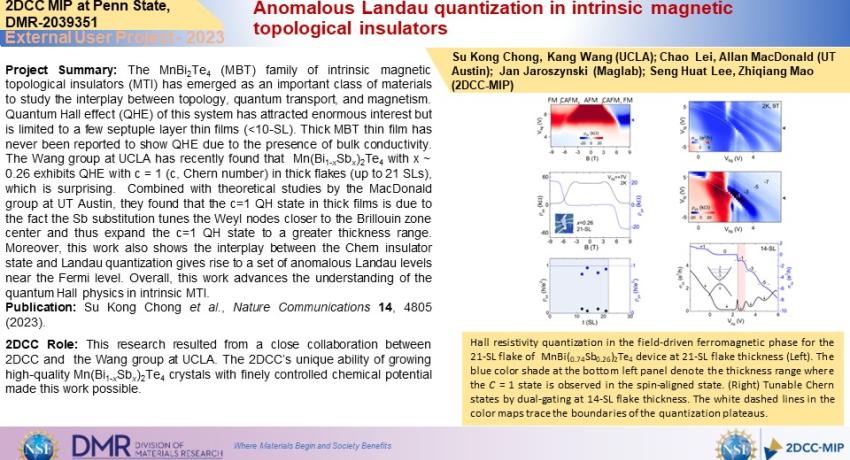The MnBi2Te4 (MBT) family of intrinsic magnetic topological insulators (MTI) has emerged as an important class of materials to study the interplay between topology, quantum transport, and magnetism. Quantum Hall effect (QHE) of this system has attracted enormous interest but is limited to a few septuple layer thin films (<10-SL). Thick MBT thin film has never been reported to show QHE due to the presence of bulk conductivity. The Wang group at UCLA has recently found that Mn(Bi1-xSbx)2Te4 with x ~ 0.26 exhibits QHE with c = 1 (c, Chern number) in thick flakes (up to 21 SLs), which is surprising. Combined with theoretical studies by the MacDonald group at UT Austin, they found that the c=1 QH state in thick films is due to the fact the Sb substitution tunes the Weyl nodes closer to the Brillouin zone center and thus expand the c=1 QH state to a greater thickness range. Moreover, this work also shows the interplay between the Chern insulator state and Landau quantization gives rise to a set of anomalous Landau levels near the Fermi level. Overall, this work advances the understanding of the quantum Hall physics in intrinsic MTI.
2DCC Role: This research resulted from a close collaboration between 2DCC and the Wang group at UCLA. The 2DCC’s unique ability of growing high-quality Mn(Bi1-xSbx)2Te4 crystals with finely controlled chemical potential made this work possible.
What Has Been Achieved: For the first time, this study demonstrated that the Hall quantization of Mn(Bi1-xSbx)2Te4 thin flakes can extend up to 21-SL layers in their spin-alignment ferromagnetic states. Additionally, this work also reveals that the Hall quantization states, characterized by Chern numbers, can be fine-tuned through electrostatic gating in high-electron-mobility flakes. In collaboration with the MacDonald at UT Austin, a comprehensive theoretical model was developed, which unveils anomalous Landau levels near the Fermi level.
Importance of the Achievement: The anomalous Landau levels arising from the Weyl-mediated bulk spectrum of unconventional Landau levels expand the knowledge and understanding of the quantum Hall physics in intrinsic magnetic topological insulators.
Unique Feature(s) of the MIP that Enabled this Achievement: Synthesis of high-quality, ultra fine-tuning Mn(Bi1-xSbx)2Te4 single crystals are extremely challenging due to the disorders caused by its non-stoichiometry compositions. The 2DCC has developed a unique protocol to grow Mn(Bi1-xSbx)2Te4 single crystals with good quality and precisely controlled chemical potential, which enables this collaborative work.
Publication: Su Kong Chong, Chao Lei, Seng Huat Lee, Jan Jaroszynski, Zhiqiang Mao, Allan H. MacDonald & Kang L. Wang, “Anomalous Landau quantization in intrinsic magnetic topological insulators” Nature Communications 14, 4805 (2023). https://doi.org/10.1038/s41467-023-40383-x
Acknowledgments: This work was supported by the National Science Foundation the Quantum Leap Big Idea under Grant No. 1936383 and the U.S. Army Research Office MURI program under Grants No. W911NF-20-2-0166 and No. W911NF-16-1-0472. Support for crystal growth and characterization was provided by the National Science Foundation through the Penn State 2D Crystal Consortium-Materials Innovation Platform (2DCC-MIP) under NSF cooperative agreement DMR-2039351. A portion of this work was performed at the National High Magnetic Field Laboratory, which is supported by the National Science Foundation Cooperative Agreement No. DMR-1644779 and the State of Florida.
